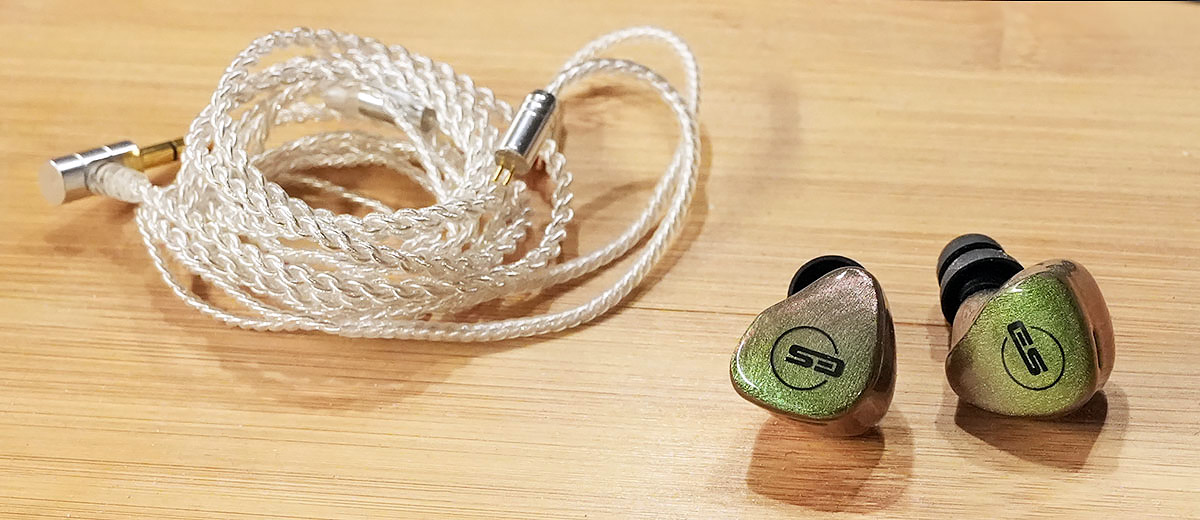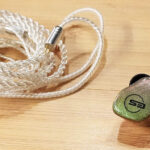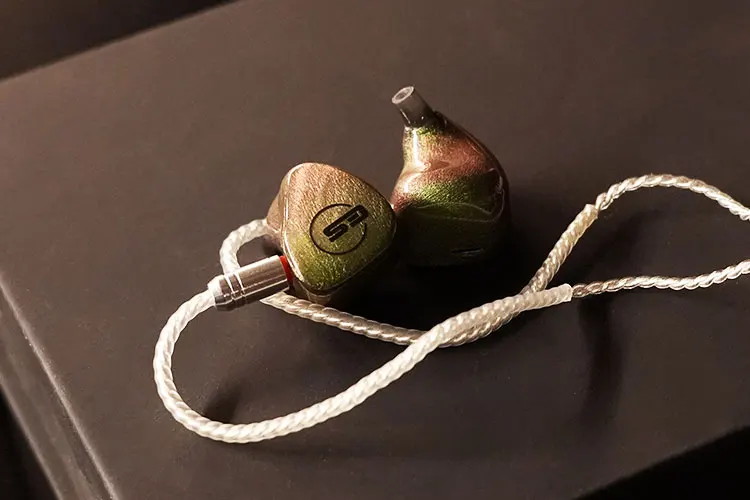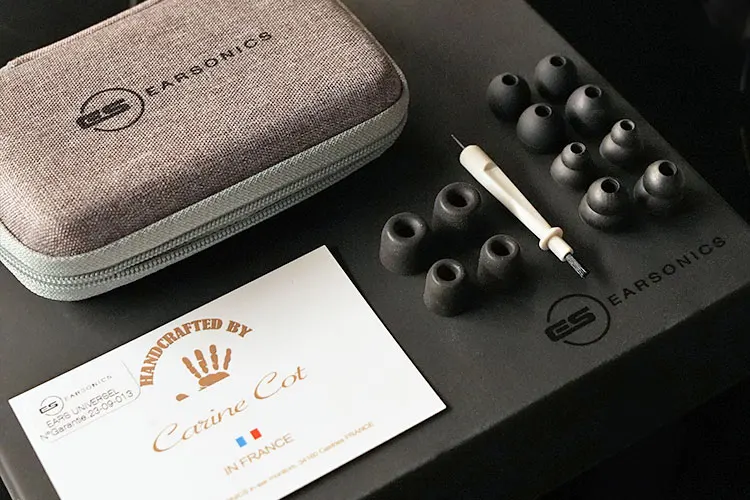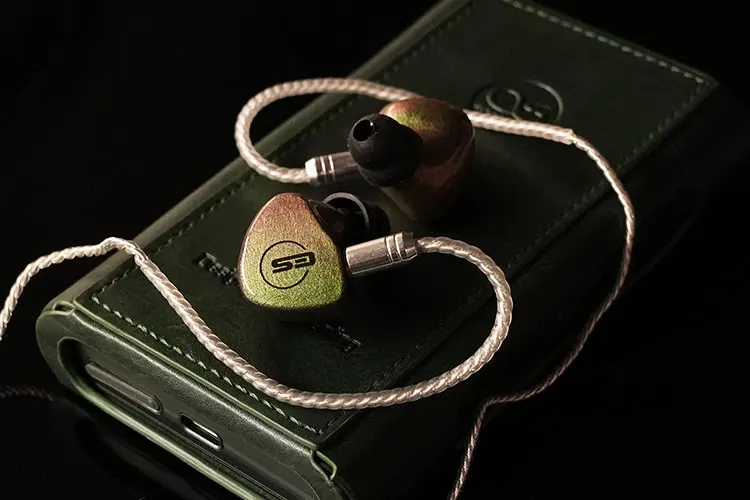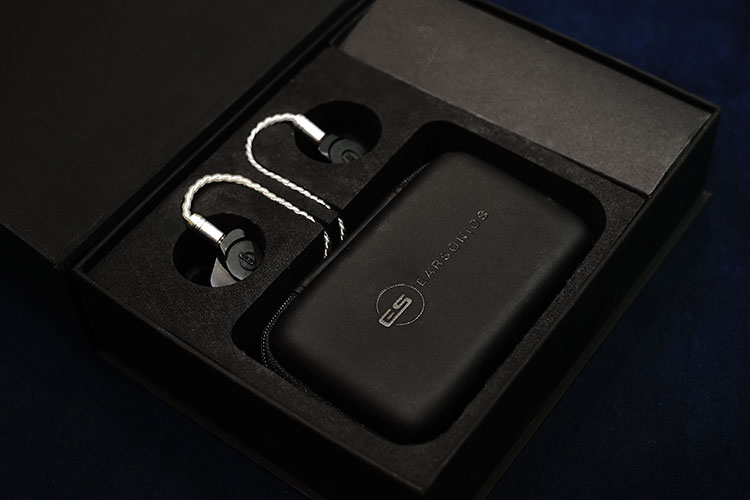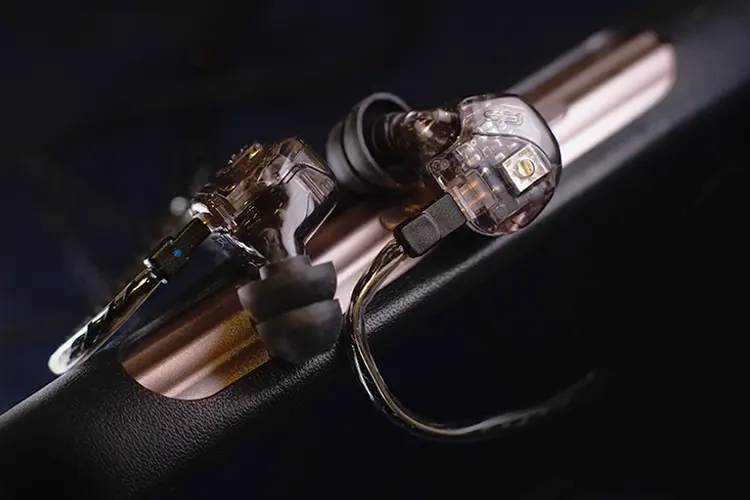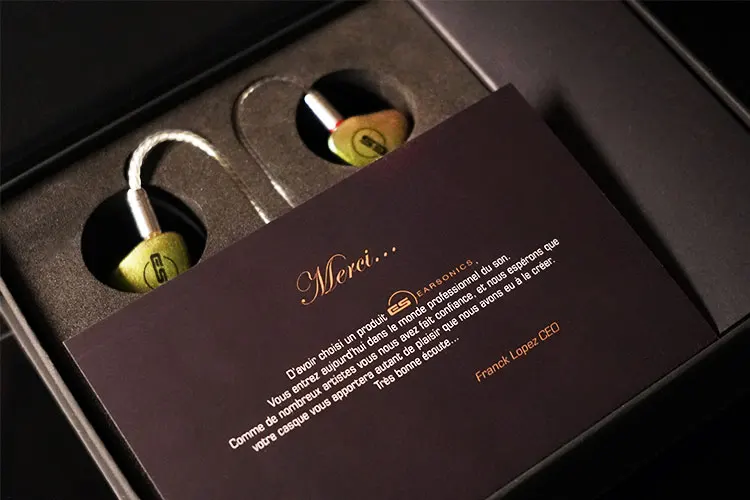We review the Earsonics Elements, which is a hybrid single dynamic and dual BA driver universal IEM with a hand-finished 3D printed resin shell. It is priced at €399.
Disclaimer: This was sent to us as a sample for our honest opinion. Headfonics is an independent website with no affiliate links or services. We thank the team at Earsonics for giving us this opportunity.
To learn more about the Earsonics products we have previously discussed on Headfonics click here.
Note, that this article follows our latest scoring guidelines which you can read here.
The Earsonics Element IEMs is a play to the opposite of the house of their Pro Series, the last of which we reviewed was the SWITCH 300 PRO. This latest hybrid driver IEM is designed as part of the company’s audiophile range which also includes the ONYX.
These IEMS feature a distinctive three different types of hand-painted Chameleon-like finishing, reminiscent of lacquer paint jobs found on sports cars, and are priced in the mid-fi range of €399.
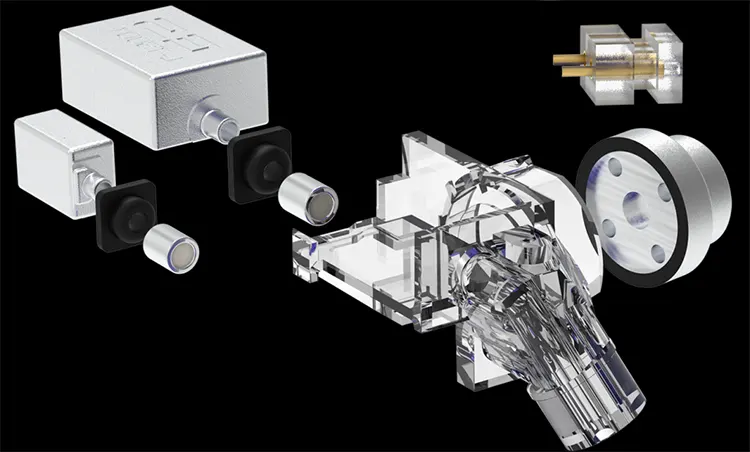
Tech Highlights
The Elements is a universal multi-driver IEM that shares some engineering merits with the metallic model ONYX, as both feature a hybrid, 1+2 driver design.
It uses two discreet transducers instead of a dual BA. Notably, a larger transducer is dedicated to bass reproduction, ensuring a powerful and immersive low-frequency experience.
The Elements uses a 3-way crossover design, and an impedance corrector is also implemented.
Similar to the higher-end, metallic-housed models, inside the Elements is a transparent acrylic skeleton that holds the three drivers in place. From Earsonics, the technology enhances the phase control as well as shaping their target frequency response.
Design
The housing of the Elements is made entirely of acrylic material and comes in three color themes: “OCEAN” (blue), “FIRE” (red), and “FOREST” (green).
Previous Earsonics models were often more masculine or geared towards professionals. However, this time, the Elements introduces a more artistic touch with its hand-painted design and distinctive colors.
In particular, the FOREST model we received exhibits a color-shifting, green-purple pearl sheen that is well-layered. The body has a darker tone, creating an even better contrast. The other color options are metallic and glossier, each offering a distinct visual appeal.
In addition, you will find a rectangular vent on the bottom of the earphones, and this is the first time I have seen such a design. Despite the vented arrangement, the Elements does have excellent passive noise cancellation thanks to the extended nozzle.
Comfort & Isolation
The Elements earphones are incredibly lightweight, benefiting from the ergonomics derived from the higher-end metallic models that have already been proven to provide a great fit. The change to acrylic design lowers weight and in turn, contributes to enhanced comfort.
The medium-sized earphone with extended nozzles sits well in my ears, effectively blocking out ambient noise, though you can feel some degree of driver flex. I brought the set along for a short flight and found that they provided a sufficient seal and passive noise cancellation to effectively block out engine noise.
Stock Cable
The Elements comes with an Earsonics Hi-res 4C cable, which uses a 4-wire SPC cable with an oxygen-free 300D Kevlar core that gives it more strength.
The cable is terminated with a 3.5mm plug but no balanced 4.4mm alternative. The connectors are classic 2-pin 0.78mm plugs and have a silver-colored appearance which looks quite premium while being very light and flexible.
Packaging & Accessories
The Elements comes in a packaging that is styled similarly to ONYX’s packaging layout. Inside, you will discover a sleek carrying pouch in a stylish grey color, along with cleaning tools and various ear tips.
The set of ear tips includes 2 pairs of memory foam tips, 2 pairs of mono-flange silicone tips, and 2 pairs of bi-flange tips. It’s worth noting that the insertion depth is quite deep for the bi-flange tips which helps deliver the bass more efficiently.
Additionally, there is a card that informs users about the skilled crafters in France who hand-built the earphones, which undoubtedly enhances the entire experience.
Sound Impressions
The Earsonics Elements has been burnt in for more than 100 hours and I am mainly pairing it with the Shanling M6 Ultra, the FiiO R7, BTR15, and the xDuoo XD05 Pro for the following sound impressions.
Summary
The Elements can deliver a punchy, well-separated, and expansive output with significant bass power and texture even when used with dongles like the FiiO BTR15.
With less powerful sources the sweet spot is at a slightly high volume as the vocal has a laid-back position, while powerful gears may empower the mid-lows more for the vocalist to stand out more clearly.
Generally, the Elements exhibit a gentle V-shaped sound signature with smooth vocal delivery, extending well into the lower register.
The low end is intimate, offering ample power and air, while not being very strongly colored as it stresses more on the fundamental bass frequencies. The upper frequencies have enough intensity to accompany the strong bass and good clarity is maintained.
Bass
Within the Elements is a 1+2 structure where the dynamic driver is sensitive to sources and may deliver flat bass when the source lacks power, and it would feel out of sync with the BAs that handle the upper frequencies in a firmer and faster manner.
When driven properly, there is a rich sub-bass presence and a good sense of depth with the Elements. It is clear that more bass details can be picked up when a more controlled and powerful source is paired.
I like how saxophones and bass guitars sound full and textured, and lower notes on the piano are well-weighted with good air. While it sounds very expansive in the bass it doesn’t feel hollowed out with sufficient mid-bass intensity.
Mids
The midrange on the Elements is delivered smoothly, and the midrange is carefully tuned to not be overpowered by the lower frequencies.
Although the tuning leans slightly laid-back, the midrange instruments and vocals are well-defined. It is particularly enjoyable for listening to vocalists with powerful or higher-pitched voices, or when the accompanying instruments are also highlighted.
Guitars, drums, and cellos in the midrange range are presented with smoothness and satisfactory resolution. They are spaciously separated with good air, which has great synergy with the upbeat Jazzes and French pops I tested.
Treble
The treble is sufficiently extended for harmonics and air to be heard, and it has successfully smoothened out unwanted spikes while sounding clean and undamped with vocals. The tuning has good synergy with dance music, especially those with an ethereal vocal line or rich harmonics in the mix.
The sharpness and power of the treble are quite dependent on the source being paired with, so you may have to EQ down the bass slightly if you want it to sound more exciting.
For longer listen sessions, the stock tuning might be more friendly and less fatiguing as it doesn’t overly boost the treble presence, with sufficient air in the low end.
Soundstage
The Elements create a stage that resembles a lecture hall in size, offering good width, especially. The sub-bass extends quite deeply, contributing to a good sense of layering.
The positioning of vocals and instruments across the midrange feels spaced out, yet not too far from the listener just marginally before what I would call laid back. With some of the treble spikes smoothed out, followed by a sharp roll-off, the Elements avoid sharpness but sacrifice some openness.
The vocal image may sound obscure when plugging the Elements into a weaker source such as my laptop, and when driven by a more resolving system.
For example, using the RME ADI 2 Pro with higher decoding quality, or even the BTR15, the positioning gets much more distinct, and with much more realistic weight.
Synergy
Efficiency
As mentioned before, the bass might sound a bit overwhelming on weak sources and when paired with an amplifier or a more powerful DAP, it sounds much more responsive and agile.
Together with the more prominent sub-bass the bass tuning works great with dubstep, EDM, game BGMs, metal, or anything with strong synthesized or strong bass lines.
I would still consider the Elements rather easy to drive and can reach loud volumes, as indicated by their specifications of 122 dB/mW and 17Ω. Increasing the gain effectively boosts speed and enhances the transient response.
Additionally, the earphones are not very sensitive, meaning they don’t easily pick up noise even when paired with a powerful amplifier on higher gain settings for example the xDuoo XD05 Pro on high gain that is designed to service small cans.
Pairings
There is significant potential for the Elements to scale further when paired with superior decoding and output devices that possess stronger resolving power. This improvement is primarily observed in the bass, enhancing control and detail retrieval capabilities.
When testing with the FiiO R7 and the Shanling M6 Ultra, there is ample power to drive the Elements, resulting in a dynamic and controlled sound, with decent separation between instruments and the vocal.
The overall tonal balance of the Elements remains consistent when adequately driven, although it is worth noting that the R7 provides a cleaner and more agile sound signature, while the M6 Ultra adds warmth and texture to the vocals.
The output signature is also dependent on the gain level, where a higher gain will shape the upper frequencies sharper and faster in the bass, and a lower gain more on the relaxing side with softer bass response.
Select Comparisons
Earsonics ONYX
Technical
The Earsonics ONYX is a hybrid single dynamic and triple balanced armature IEM featuring a 3-way, 4-driver design. It incorporates Earsonics’ ‘Technologie Hybride’ and Acrylic Heart infrastructure, combining phase alignment measures for coherent sound and ‘Truewave’ Technology for tuning.
With a sensitivity of 122 dB/mW, a frequency response of 10 Hz – 20 kHz, and an impedance of 16.5Ω, which is very similar to the Elements.
Design
The name “ONYX” accurately captures the essence of the design, as its dark, glossy metallic housing resembles the subtlety of the gemstone itself. In contrast, the “Elements” exhibits a more playful and sporty appearance with its color-shifting paint job.
These two models showcase completely different styles and employ different materials. Deciding which one is better is probably a matter of personal preference but if it comes to weight and comfort, the Elements would be preferable.
Performance
One of the key distinctions between the ONYX and the Elements is that the ONYX offers a much cleaner sound signature. Consequently, when the ONYX is paired with less powerful gear, it maintains better coherence and clarity in its audio reproduction.
This may be attributed to the driver configuration and nature, where the dynamic driver in the Elements is more demanding for power.
The sound signatures of the ONYX and the Elements are notably differentiated. The Elements offer a more relaxing sound and much fuller, natural bass. The ONYX exhibits stronger technicalities, particularly in terms of transient response in both the treble and extends more effortlessly, allowing more treble details to be detected.
Earsonics SWITCH 300 PRO
Technical
The Earsonics SWITCH 300 PRO utilizes three individual balanced armatures that are connected through Earsonics’ 3-way HQ crossover with impedance correctors. This design is reminiscent of swapping out the dynamic driver on the Elements for a balanced armature.
However, the SWITCH 300 PRO stands out with its unique feature: a switch that offers three distinct tuning modes named “Tight” and “Warm” aside from the neutral “Standard” mode, which functions as low-cut and high-cut filters respectively.
This feature allows professional users to effortlessly switch between different sound modes, focusing on specific frequencies and catering to their needs, and the specification with an impedance rating of 31.5 to 41.5Ω and 119 dB/mW sensitivity allows the earphones to sound more consistent with different sources.
Design
The SWITCH 300 PRO features a professional and sleek appearance, featuring a transparent housing that offers a glimpse into the internal components and their installation. In contrast, the Elements has a more extravagant design while still providing the same level of isolation.
Performance
While both earphones feature a triple-driver 3-way design, their tuning and structure are very different as they are aimed at different audiences.
When comparing the stock tuning of the SWITCH 300 PRO to the Elements, it becomes evident that the SWITCH 300 PRO exhibits stronger neutrality and coherence.
It offers a more neutrally weighted and cleaner bass response with a faster attack speed. The Elements tilts more to the low end and sounds more full-bodied, engagingly weighted, and has more energy for genres like EDM or Rock.
The “Warm” tuning on the SWITCH 300 PRO sounds closer to the sound of the Elements, though the Elements is richer in bass harmonics and has a more organic coloration, also reaching deeper in the subs.
Both earphones benefit from more powerful sources to deliver better dynamics and clarity, particularly in the low frequencies.
Using the xDuoo XD05 Pro to test, the SWITCH 300 PRO exhibits less alteration in the upper frequencies and effortlessly extends, allowing for the revelation of airy details.
In contrast, the Elements presents a more colored and polished tuning profile, particularly suitable for sharper mixes, which contributes to an overall more relaxing listening experience and lusher vocals.
Our Verdict
Earsonics’ introduction of the Elements represents a more ‘playful-sounding’ and vibrant-looking addition to their Audiophile series of French-made earphones, diverging from their more professional or metallic designs.
The mesmerizing color-shifting paint on the Elements is captivating, and it is not just a pretty façade. I thoroughly enjoyed the energetic and mellow tuning profile, which does well with ethereal voices and retro Synthwave pop.
Just ensure that you have a capable source, and the Elements will deliver an immersive soundscape.
Earsonics Elements Technical Specifications
- Sensitivity: 122dB/mW
- Frequency response: 10Hz – 20kHz
- Impedance: 17 ohms
- Drivers: 2 balanced drivers and 1 dynamic driver / 3-way HQ crossover with impedance corrector

